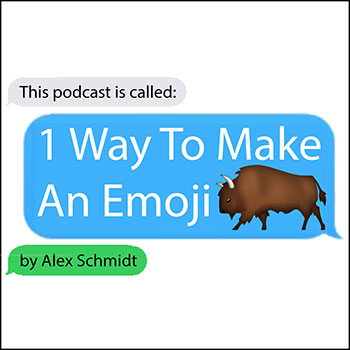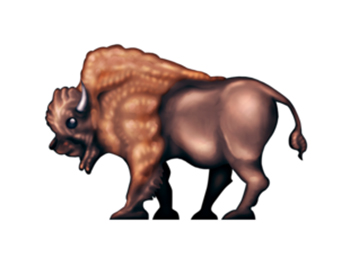3 Emoji With Awesomely Bizarre Origin Stories

Hey there Cracked readers. It's me, Alex Schmidt. Maybe you know my voice from The Cracked Podcast or the Kurt Vonneguys podcast. Maybe you know my voice & face from a couple hundred Cracked videos (sometimes featuring helmets). Or maybe you memorized every Jeopardy! episode that aired in mid-October 2018, because you are some sort of pointless genius.

Anyway I'm sliding into your DMs (digital magazines) to blog at you. Because I want to share my new podcast miniseries with you. It's called 1 Way To Make An Emoji. All the episodes come out next week! Subscribe now to get them. You can subscribe on Apple, or on Spotify, or on Stitcher, or by searching the name "1 Way To Make An Emoji" in your podcast app.

Have you ever noticed there are new emoji every year? Have you ever wondered where they come from? Subscribe to "1 Way To Make An Emoji" for the amazing answer to that question. And read this blog here for some of the strangest emoji origin stories of all time.
Pile Of Poo
...perhaps better known as "the smiling pile of poo emoji" or "the poo emoji."

I've learned a lot about emoji. One learning: every emoji has an official name. The official name for this emoji is "Pile Of Poo". Any other description is technically inaccurate.

But like, c'mon, that emoji is too bizarre and cartoonish to be called a "Pile of Poo." Right? That's like seeing the giant Snoopy balloon in the Macy's Thanksgiving Day Parade and calling it "a dog."
Anyway let's get into its origins. One myth to dispel right away: it's not chocolate ice cream. It is shaped exactly like the top of the ice cream emoji, but that's a weird artistic overlap and nothing more. It's the opposite of that story about how Homer Simpson was almost secretly Krusty. Ain't no chocolate in that swirl.
The poo emoji's origin dates back to the origin of all emoji. Super short version: in 1998, one designer working for one Japanese cell phone carrier created 176 tiny images. Then his company attached each image to a code point. Those 176 images + code points were the first emojis. So on that company's phones, each image could be typed like a letter, number, or other character.
Technical stuff here: when you type a letter or number or other character, you are selecting a code point. Thanks to a digital non-profit named Unicode, the code points for letters and numbers and other characters match up across all digital devices and platforms. Thanks to Unicode's efforts, I can type the phrase "thanks to Unicode's efforts" and know those same letters will pop up on your device.

The first emoji were a hit. Other Japanese cell carriers rolled out their own sets, to keep up. But the different carriers did not coordinate their emoji images or their emoji code points. So if you texted a friend who had a different cell phone provider, your could output as or or .
Luckily, Unicode adopted emoji and standardized the code points in 2010. But for the 12 years before that, emoji were a lawless mess. The emoji system was like the Wild West!
Policed by Twitter's brave emoji sheriffs.
And here's another amazing thing: in 2007, Google launched an internal project called "Mojo" to add emoji to their Gmail e-mail service. There's an amazing oral history of that project written by Lauren Schwartzberg for Fast Company. And you're gonna want to click that link, because they've got the incredible original Gmail "pile of poo" emoji. It is faceless. It is more realistically gross. And it has an animated cloud of flies buzzing over it. Go look at it!
More fun stuff: Google's team fought each other bitterly over whether to allow the pile of poo emoji in their emoji set. How did the poo win out? According to Google's Darren Lewis, "We argued that would add complication to the system and take longer--that's usually a good way to get a feature in." You're reading that right: America has the pile of poo emoji because our instinct to be lazy overwhelmed our instinct to censor everything.
And by the way, the emoji set has many Japan-centric entries. Notice them sometime! If you are not Japanese, the time you spend scrolling through the Food & Drink emoji category (featuring dango, oden and the classic fish cake with swirl) might be the most multicultural part of your day. For real! It's multicultural! Even if you're only swiping through the Food & Drink category to find erotic fruits!

Japanese culture also gave the world Dr. Slump, a popular 1980s manga, adapted to anime, featuring friendly cartoon pile of poop characters. That's a key touchstone for the Pile of Poo emoji's style. And you've probably never even seen it!

And the Pile Of Poo emoji's cultural rabbit hole runs deeper than that. This great Dan Hopper piece details the rise and fall of the proposed "frowning pile of poo" emoji. Short version: Unicode sees the logic for adding it, but doesn't want to open the floodgates for endless further poo-faced facial expressions. Also this great Ian Fortey piece reveals how the Pile of Poo emoji drove Jordan Peele to quit acting. Short version: the makers of The Emoji Movie tried to cast Peele as "Poop", and that mere offer convinced Peele he should focus on directing full-time.

One bizarre emoji had a worldwide ripple effect. An emoji that's a combination of Japanese cell phone innovation, American laziness, and a slice of manga/anime canon I know very little about. That is how we got the most famously weird emoji.
Person In Suit Levitating
But how did we get the least famously weird emoji? Did you even know this is an emoji?

It's true! Check your phone. He's in the section after the faces. In between the set of dancing people and the oddly robust set of Playboy Bunnies. And...huh? Why is that an emoji? Who decided to equip every keyboard on Earth with a mystical thin Blues Brother?
For the answer, I turned to my friend Joe Veix, an incredible comedy writer and Internet spelunker. He delved into the origins of "Person In Suit Levitating" for Newsweek. It's a story that begins in the late 1990s. A rich time for dopey Internet experimentation. America had nothing to do but watch Michael Jordan win, enjoy its unprecedented economic prosperity, and fool around on The World Wide Web.

In our era, we stay home and stare at our browser all day because of a global pandemic. In their era, they stayed home and stared at their browser all day because browsers were thrilling new technology. Browser innovation was the hot tech field. So when Internet Explorer 4.0 (lol so 90s) was in development at Microsoft (lol so 90s), they equipped that browser with "Webdings" -- an Internet-optimized version of that goofy Wingdings font no one needs. Microsoft staff built out Webdings to include 230 characters.

If you squint at the right side of the fifth row of that Webdings character set, you'll see a proto-version of Person In Suit Levitating. And he got in there because a Microsoft employee loved ska.
Jerry Dammers was the keyboard player for a ska group called The Specials. In 1979, he founded a company called 2 Tone Records to release the group's music. And his band & label put out this album exclusively in Japan. The fella on the cover there is a fun version of the band The Specials' logo: a man dressed in sunglasses, a black suit and a porkpie hat, because that outfit was typical of the "rude boy" style of the British ska revival.

You might think that makes this emoji Japan's fault. But no! This emoji was Made In The USA! Microsoft typography department employee Vincent Connare loved ska so much, he got his hands on this rare Japanese LP. Meanwhile, Connare's manager complied a list of concepts for Microsoft's team to symbolize in Webdings. The list included "jump." Connare saw that, thought "my Japanese record collection", and a weird Webdings character was born.
Wedbings launches. Years pass. Unicode standardizes the world's emoji set. And then in 2014, somebody asked Unicode to turn that oddly specific Webding into an oddly specific emoji. And for some reason Unicode said yes.
That kind of thing can just happen! Because anybody can propose an emoji to Unicode. And if Unicode says yes, it gets it add it to every digital device on Earth. Anybody can do that.
Weird, right? Anybody in the entire world can do that.
Bison
...including me! Alex Schmidt! Your pal! I proposed the bison emoji. Unicode said yes. Also you can't use it yet. The emoji rolls out to world keyboards sometime in the fall of 2020.
It took more than a year of research and effort to create the bison emoji. It's brought a lot of great folks into my life. It's the subject of my new podcast, so PLEASE SUBSCRIBE because no one blog can contain the full story. But here's a little bit of it.
When you saw that "Bison" entry header up there, did you immediately know what that is? You should have! After all, the American bison is the largest land mammal in the Western Hemisphere. The American bison is the official national mammal of the United States. And the American bison...is the animal basically every American calls "the buffalo."

You probably didn't hear "bison" and see that in your head right away. Because in America (number one country) we call it the "buffalo", because of our proud heritage of making mistakes. If the National Park Service is right, the French word "boeuf" ("beef" in American) got misused and mixed up around bison one too many times. So if you say "buffalo", you gotta hope people know you're not describing Africa's Cape buffalo (the one from Big Buck Safari) or the Asian water buffalo (the one from the emoji keyboard). In our interconnected world, the word "buffalo" is just plain confusing. It's as if "buffalo" lacks a standardized global code point.

I had many reasons for putting more than a year of effort into proposing the bison emoji. (Subscribe to the podcast to hear them all!) And one reason is that a bison emoji is a clearer representation of that species than America's most common word for it. I think this fixes that issue, a little bit! Just by making this little guy an option!

It's not a huge deal. It's not changing anybody's life. Also that Emojipedia drawing of what the bison emoji might look like is insanely swole, so this is turning out more erotic than I'd planned. Anyway, I like the idea of the world's communication being a little bit clearer. I hope you'll listen to the podcast about that and more. And I hope you're looking forward to your future bison emoji.
Top Image: Mego Studio/Shutterstock